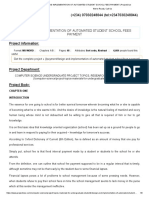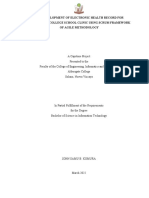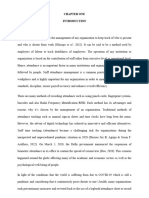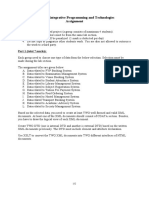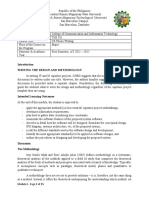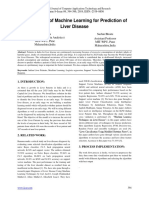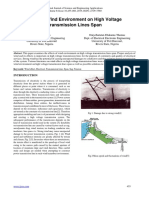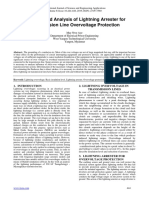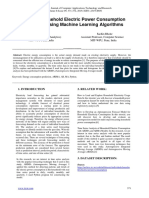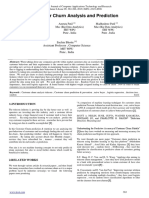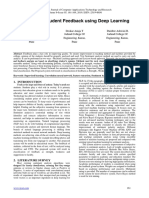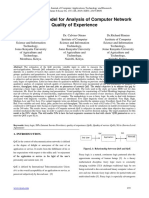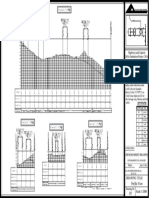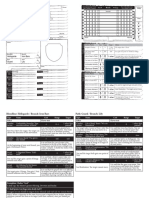International Journal of Science and Engineering Applications
Volume 8–Issue 10,461-465, 2019, ISSN:-2319–7560
Electronic Transcript Management System
Esite Jeremiah Tamarankuroemi
Student, University of Port Harcourt
Port Harcourt, Rivers State
Nigeria
Abstract: There has been a recent shift from manual to an automated approach for transcript management. A management system capable
of result input and management as well as a system for graduates to make transcript requests from any internet enabled web browser.
This approach is very much effective in transcript and result management for any higher institution within Nigeria operating a similar
grading system to that of University of Port Harcourt. The current system for managing results has proven to be inefficient making it a
necessity for a faster and efficient approach. Using modern web tools, a web-based transcript management system can be developed to
solve the problems of the current system being used.
Keywords: Transcript, Web, Web-Based, Web Browser, MySQL
I. INTRODUCTION II. CURRENT MANUAL APPROACH
Recent developments in Nigerian higher institutions have seen a
rising need to automate transcript management. Several means of In most Nigerian higher institutions, result management is the
achieving this via a software-based approach exists. duty of the Exams and Records administrative department of the
school.
Software can be simply referred to as “The programs,
programming languages, and data that direct the operations of a Each department also have copies of every student’s result. In
computer system” [5]. processing a student’s transcript using University of Port
Harcourt as a case study, the following steps are taken as
Result processing can be seen as a continuous process of presented in the block diagram of fig. 1.
converting data (scores, grade points, credit units etc.) into a
definite and meaningful information such as statement of result, Firstly, payment is made to a designated bank account. This
transcripts etc. [1]. Students’ performances are judged based on amount is dependent on the transcript delivery destination. After
the outcome of their results. If an adequate result management the payment has been made, the student then goes to the Exams
and processing system is not in use, there could be problems and Records department with a formal letter requesting for his
which at the end would diminish the aim of which results and academic transcript. The letter is forwarded to the student’s
consequently transcripts were meant for. department requesting for copies of his results. These copies are
then sent back to the Exams and Records office for compilation
A transcript is documentation of a student's permanent academic and then sent to the office of the Registrar where it is signed and
record, which usually means all courses taken, all grades sent back to the Exams and Records office. The transcript is then
received, all honours received, and degrees conferred to a student sealed and sent to the stipulated address through a courier service.
[6].
Bank Payment for transcript
As students go through different educational processes to earn a
degree, the need for the sending, processing and grading students
using paper records become cumbersome and unmanageable.
Currently, sending and receiving paper transcripts remains the Exams and Records
most common form of record transfer, even though labour-
intensive, manual keying of data must occur on both ends of the
transaction [3]. A web-based electronic transcript management Request for results from
and processing system will help in reducing problems that stem department
from the manual means of processing. In this system, only
authorized user(s) would have access to the system.
Confirmation and
The web-based transcript management system meant for
Compilation of student’s
processing of the transcripts will be done using HTML5, CSS3
and jQuery for front end design, AJAX for interaction with PHP result
(Hypertext Pre-Processor) which is server side programming
language and MySQLi (My Structural Query Language
improved). The languages were chosen based on their flexibility Transcript sent to registrar
and ease while working locally using a XAMPP server. to be signed
With proper programming practices, students’ Grade Point
Average (GPA) and Cumulative Grade Point Average (CGPA)
can be calculated on computation of the necessary data. Transcript delivery
Fig. 1: Steps for manually acquiring transcript in University of
Port Harcourt
www.ijsea.com 461
� International Journal of Science and Engineering Applications
Volume 8–Issue 10,461-465, 2019, ISSN:-2319–7560
This method is slow, error-prone and stressful. These problems
can be diminished by making use of a computer based processing
system or an electronic transcript management system [4].
III. WEB-BASED APPROACH OF
TRASCRIPT MANAGEMENT
Steps have been taken towards automation of transcript
management with the use of excel spread sheet. Here, the
programming is hard coded into the cells, and cell referencing
which could be applied to monitor and track students’ Fig. 3: MySQL database showing the structure of the lecturers’
performances such as cumulative points [2]. user accounts table
In this paper, a web-based system of database management of List of all courses: All courses available in the school will also be
transcript is our primary focus. MySQL database is made use of. registered into the database by the administrator.
The database is structured in such a way that it allows for proper
storage of useful student and staff date. This approach, though
tested and found to be working as expected, has however not been
put to use widely [7].
Three access levels will be considered to allow for the success of
this approach: Administrator, Student and Lecturer access levels.
These three levels of access will be powered by the content of
their database tables.
Administrator Access Level: The administrator (admin) has
complete access and control of other users. The administrator can
access the following tables in the database:
Students’ personal details: This table contains students’ Fig. 4: MySQL database showing the structure of the list of
matriculation number and other personal information. Each courses
student can then access their individual portals by making use of
their matriculation number and password. Changes can be made Lecturers’ courses: Every semester, each lecturer is set to teach a
to their personal details only by the administrator. particular course which has to be updated by the administrator.
This information is updated in the MySQL database and can is
represented as seen in fig. 5. Each lecturer can only input results
of student for courses he currently handles.
Fig 5: MySQL database showing the structure of the course-
Fig. 2: Students user accounts on the MySQL database lecturer table
Lecturers’ personal details: Personal accounts of lecturers can be Transcript requests: When requests for transcripts are made by
created by the administrator which will include the course the students, the administrator changes the status of the request to
lecturer would take for that semester. The information that will be show if it was granted or not as well as the stages of processing it
contained in the database for each lecturer can be represented as has reached.
seen in fig. 3.
www.ijsea.com 462
� International Journal of Science and Engineering Applications
Volume 8–Issue 10,461-465, 2019, ISSN:-2319–7560
one of the column name as primary key. For this work, our
primary key is the ‘id’. As seen in fig. 9, each data table can be
emptied or dropped. For the purpose of this work, a total of seven
tables are required.
Fig 6: MySQL database showing the structure of the transcript
request table
Student Access Level: The student portal allows the user to login
to his personal account in order to make register for semester Fig. 9: MySQL database showing the different tables from
courses, view results and make requests for a transcript. localhost using XAMPP
The courses registered will then be filled with their appropriate Every account listed - administrator, lecturer and student – can be
scores by the corresponding course lecturer. accessed by a user through the flow diagram shown in fig. 10.
Fig 7: Structure of the course registration on MySQL database
table.
With this, every student can register a course once a school
session resumes and it will also determine the courses for which
the student can be assessed by the lecturer.
Lecturer Access Level: The lecturer’s portal is set aside for
inputting the result for the course(s) he currently takes. The
lecturer can only input scores for students who registered for his
course. The score input for a course is represented in fig.8. Fig. 10: Flow diagram for logging into the Transcript
Management System (TMS)
IV. GRADE POINT AVERAGE (GPA) AND
CUMULATIVE CGPA GRADE POINT
AVERAGE CALCULATIONS
For a given semester, each student would have a GPA while a
combination of all available semester course assessments
produces a CGPA.
Necessary information for calculating the semester GPA is
available in the results table where the scores and their units are
stored. The GPA for a semester is calculated using (1).
Fig. 8: MySQL database table meant for inserting courses and
their grades for different students who registered for that course. GPA =
From fig. 8, scores for a particular course are stored in the results 𝑆𝑢𝑚 𝑜𝑓 𝑡𝑜𝑡𝑎𝑙 𝑎𝑣𝑎𝑖𝑙𝑎𝑏𝑙𝑒 𝑠𝑐𝑜𝑟𝑒𝑠 𝑓𝑜𝑟 𝑡ℎ𝑎𝑡 𝑠𝑒𝑚𝑒𝑠𝑡𝑒𝑟
database table which includes the matriculation number, course 𝑠𝑢𝑚 𝑜𝑓 𝑎𝑙𝑙 𝑢𝑛𝑖𝑡𝑠 𝑜𝑓𝑓𝑒𝑟𝑒𝑑 𝑓𝑜𝑟 𝑡ℎ𝑒 𝑠𝑒𝑚𝑒𝑠𝑡𝑒𝑟
id, semester the course belongs to as well as the session, lecturer’s
name, total score, and grade. (1)
Fig. 9 shows an implementation of the tables in the MySQL For CGPA calculation, we make use of (2).
database using a local host called XAMPP. In the database, tables
have been created for specific records as seen in fig. 2-8. Each
column is given a name and a data type allowing one to set any
www.ijsea.com 463
� International Journal of Science and Engineering Applications
Volume 8–Issue 10,461-465, 2019, ISSN:-2319–7560
𝑆𝑢𝑚 𝑜𝑓 𝑡𝑜𝑡𝑎𝑙 𝑎𝑣𝑎𝑖𝑙𝑎𝑏𝑙𝑒 𝑠𝑐𝑜𝑟𝑒𝑠 𝑒𝑣𝑒𝑟 𝑡𝑎𝑘𝑒𝑛
CGPA = .
𝑠𝑢𝑚 𝑜𝑓 𝑎𝑙𝑙 𝑢𝑛𝑖𝑡𝑠 𝑜𝑓𝑓𝑒𝑟𝑒𝑑
(2)
V. REQUEST FOR TRANSCRIPT
In requesting for a transcript, a student logs into his account
and selects the purpose for which the transcript is meant for in
terms of delivery recipient. This could be a personal copy, for
foreign institution or a Nigerian institution. This will determine
the cost that will be paid by the student for the whole process.
Transcript request by students is shown by the following flow
diagram in fig. 11.
Fig. 12: Flow diagram for administrator processing of academic
transcript
With each stage of processing, the administrator updates the
status of that transcript request made by the student. This
continues until the transcript is delivered to the recipient address.
VI. CONCLUSION
An electronic transcript management system creates an avenue
for information management to be convenient, efficient and easy
to use. The application will be capable of storing and retrieving
academic records with high speed and accuracy, and presenting
useful information to its users.
The system provides an efficient means of processing, preserving
and displaying students’ results, academic records and other
relevant notices to students. As part of its benefits, it is stress-free
and speed-up the processing of students’ examination results.
Fig. 11: Flow diagram for student’s request for academic Finally, the system is flexible and runs on a web browser. With
transcript this application, the processing of students’ results is automated,
thereby reducing processing time and increasing accuracy.
When a request is made by a student for a transcript, it is added
to the request table which can be accessed only by the
administrator. Here the administrator makes checks for those
requests where payment has already been made and prints out the VII. REFERENCES
result by clicking on a print command button. This printed [1] Dada, O. M., Rajii, A. K., & Oyedepo, F. S. (2017). An Online
document is then sent to the Dean of Student Affairs for his Result Processing and Transcript Generation System: A Case Study
signature. Once this is done, the transcript is then sealed and sent of Kwara State Polytechnic. Tetfund Sponsored Kwara State
via courier service to the designated address. During this entire Polytechnic Journal of Research and Development Studies Vol. 5.
procedure, the administrator updates the status of the whole No. 1.
process so the student can view from his personal page.
[2] Ekpenyong, M. E. (2008). A Real-Time IKBS for students' results
computation. International Journal of Physical Sciences (Ultra
The processing of the transcript can be summarised by the flow Scientist of Physical Sciences), Vol. 20, No. 3.
diagram in fig. 12.
[3] Kilgore, W., Gretchen, H., & Matthew, H. (2014). Transcript
Practices and Cost at U.S. Institutions. Washington, D.C: AACRO.
[4] Okonigene, R. E., Ighalo, G. I., & E. Ogbeifun. (2008). Developed
personal record software. The Pacific Journal of Science and
Technology, 9(2):407-412.
http://www.akamaiuniversity.us/PJST.htm.
[5] Software. (2019, January 20). Retrieved from:
https://www.dictionary.com/browse/software
www.ijsea.com 464
� International Journal of Science and Engineering Applications
Volume 8–Issue 10,461-465, 2019, ISSN:-2319–7560
[6] Transcript. (2019, January 22) Retrieved from
http://www.lbwcc.edu/Content/Uploads/lbwcc.edu/files/Transcript
s.pdf
[7] Ukem, E. O., & Onoyom-Ita, E. O. (2011). A Software application
for the processing of students results. Global Journal of Pure and
Applied Sciences, Vol. 17 No. 4.
www.ijsea.com 465














